Submarine Signaling on Steamships
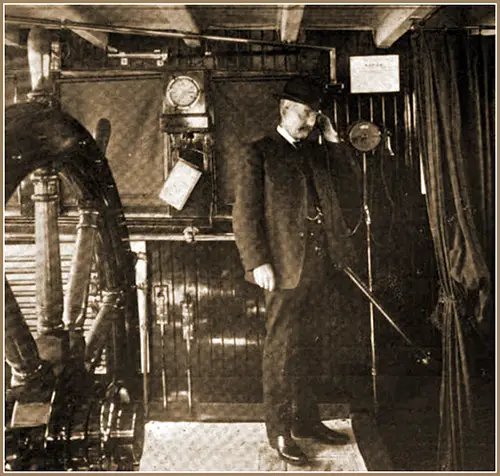
Receiving Signals in the Pilot House. The Direction Indicator Enables the Captain to Ascertain the Direction From Which the Signals Come. Cassier's Magazine, December 1908. GGA Image ID # 1d2f13759b
The success that has attended the introduction of submarine signaling by means of bells underneath lightships, or along the shore, to ships far out at sea, is one of the principal topics now engaging the attention of naval experts the world over, for it is believed that the perfection of this system of communication may be the answer to that most perplexing naval problem of modern times, which is the discovery of a method by which battleships, cruisers, and other war craft may be able to detect the approach of submarine torpedo craft in ample time to locate their position and then to destroy or render them ineffective.
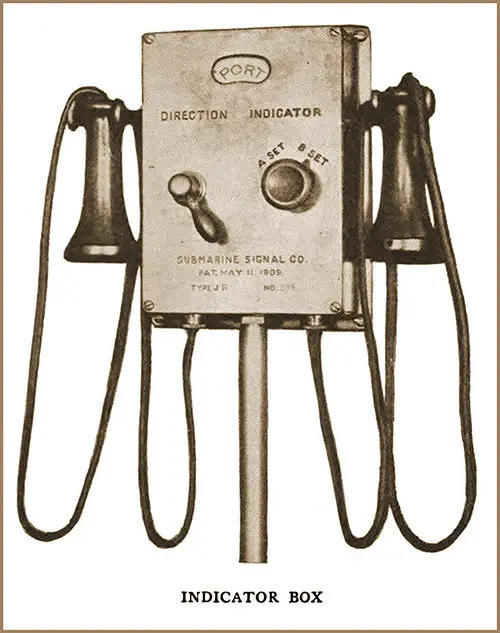
Submarine Signal Indicator Box. Submarine Signal Company, 1909. GGA Image ID # 1d301076c0
The system of submarine signaling, which as been tested with remarkable success on the great North German Lloyd liners Kaiser Wilhelm II, Kronprinz Whilhelm, and Kaiser Wilhelm der Grosse, as well as on many coastwise liners, the lightships at Sandy Hook, Fire Island, Cape Cod, and elsewhere, is based on the fact that sound travels under water at least four times the speed that it does through the air. This fact has been known and utilized by the savages on the African coast, who for centuries have been in the habit of signaling to one another by means of sounding instruments placed close to the edge of the water.
The system as now perfected may be described as a signaling apparatus, consisting of a submerged bell of peculiar design, which is attached to the bottom of a lightship or any other craft or structure, from which the signals are to be sent to a vessel at sea.
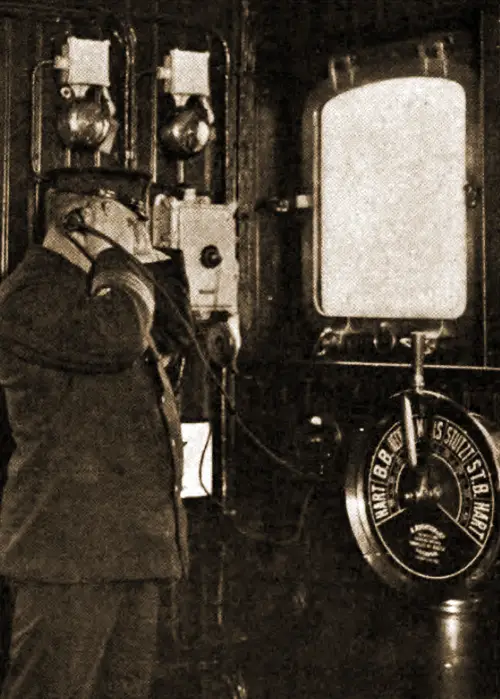
The Captain of a Steamship listening to the Submarine Signal Apparatus. GGA Image ID # 1ed0fe5212
How Submarine Signaling Works
The apparatus through which the signals are received at the bottom of the ship and then transferred by means of wires to the officer on the bridge above, may be described as a pair of sensitive electric transmitters, placed on the inside of the ship against the outer planking below the water line, one transmitter being on the port and the other the starboard side of the vessel. In the pilot-house, or on the bridge, or wherever else above deck it may be desired, there is a telephone receiver, which is connected with the apparatus below the water line.
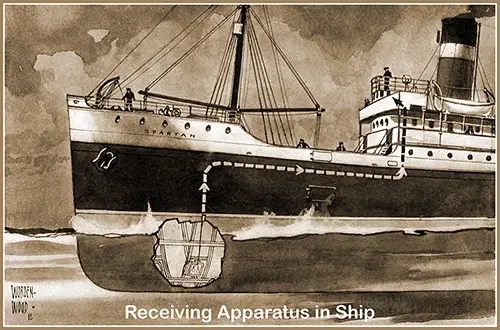
Receiving Apparatus on a Ship of Submarine Signals. Illustration by Submarine Signal Company. Submarine Signals, 1912. GGA Image ID # 1d2f6be17a
Alongside the receiving apparatus above deck is a switch by which the officer with the receivers at his ears is enabled to determine on the instant from which side the signals come. then he shuts off the other side, and in less than a minute is able to accurately to locate the bearing of the bell, its distance from the ship, and practically its exact position. The great accuracy of the results achieved by this system was never more admirably illustrated than on the voyage of the Kaiser Wilhelm der Grosse that terminated at new York recently.
On that voyage, Capt. Cueppers said the liner picked up the bells at the mouth of the Weser as she was leaving German waters, and he declared that the signals were as clear as they could possibly be, and that a novice would have hand no trouble whatever in distinguishing the numbers by which that point is known in the signal code.
Again, as the great liner neared the American mainland, the bells on Cape Cod, at Fire Island, and on Sandy Hook were just as plainly heard, and the vessel in each case was many miles at sea when the watch officer heard their tinkle.
Effectiveness of Submarine Signaling
Signal bells have minimized by at least 50 percent, the dangers to ocean-going craft incident to fogs and stormy weather along the coasts. For instance, if the Kronprinz Wilhelm is nearing Fire Island, near which point is Long Beach, whose shores are strewn with the wrecks of vessels that have been driven ashore in treacherous weather, and a thick fog prevails, the officer on the bridge, long before he nears the point, can tell exactly his position at sea and determine within a hundred yards the distance he is from the beach.
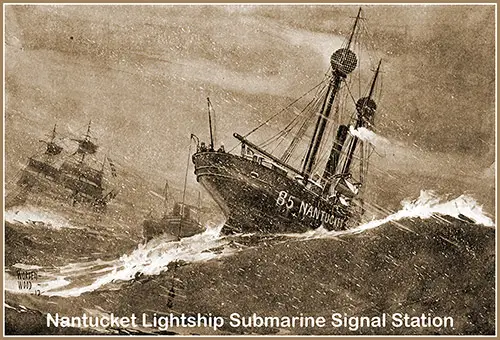
Nantucket Lightship Submarine Signal Station. Illustration by Submarine Signal Company. Submarine Signals, 1912. GGA Image ID # 1d2f45ce4b
The same is true of Cape Cod, Sandy Hook, Vineyard Sound, Nantucket Shoals, and numerous other points along the American coast, the lightships of all these stations being equipped with the submarine bells. The Canadian government is also interested in the scheme, and already plans are being perfected for the safeguarding of the Atlantic coast, as well as the St. Lawrence from it mouth to Quebec.
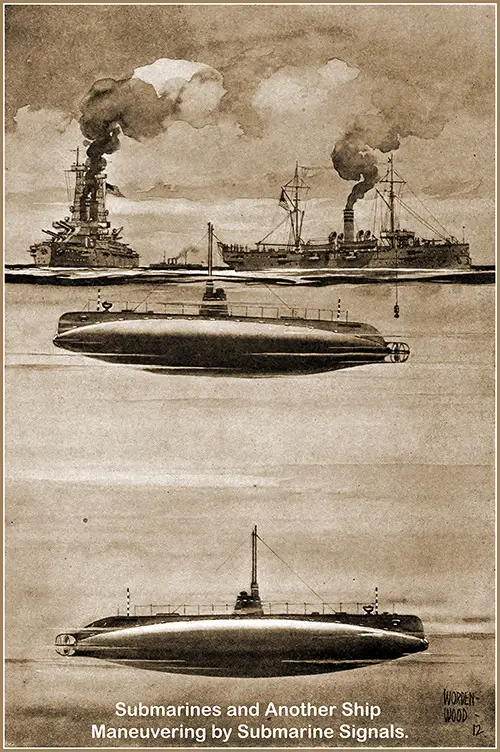
Submarines and Another Ship Maneuvering by Submarine Signals. Illustration by Submarine Signal Company. Submarine Signals, 1912. GGA Image ID # 1d2f4f3ae4
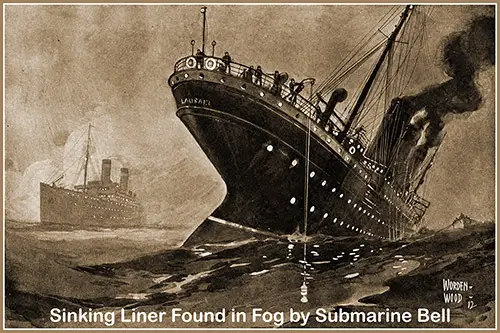
Sinking Liner Found in Fog by Submarine Bell. Illustration by Submarine Signal Company. Submarine Signals, 1912. GGA Image ID # 1d2f68a80e
Marine Review. Reprinted in the North German Lloyd Bulletin, Pages 3-4, Vol. XX, No.4, October 1905, New York and Bremen, "Submarine Signaling."
